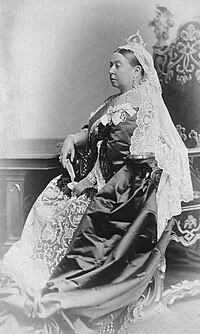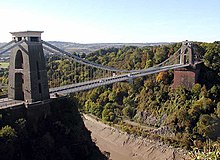This is an old revision of this page, as edited by 76.7.51.9 (talk) at 18:45, 11 December 2007 (→Introduction). The present address (URL) is a permanent link to this revision, which may differ significantly from the current revision.
Revision as of 18:45, 11 December 2007 by 76.7.51.9 (talk) (→Introduction)(diff) ← Previous revision | Latest revision (diff) | Newer revision → (diff) | |
| Preceded by | English Regency |
|---|---|
| Followed by | Edwardian period |
| Monarch | Queen Victoria |
| This article may require cleanup to meet Misplaced Pages's quality standards. No cleanup reason has been specified. Please help improve this article if you can. (September 2007) (Learn how and when to remove this message) |
The Victorian era of the United Kingdom marked the height of the British Industrial Revolution and the apex of the British Empire. Although commonly used to refer to the period of Queen Victoria's rule between 1837 and 1901, scholars debate whether the Victorian period—as defined by a variety of sensibilities and political concerns that have come to be associated with the Victorians—actually begins with the passage of the Reform Act 1832. The era was preceded by the Regency era and succeeded by the Edwardian period. The latter half of the Victorian era roughly coincided with the first portion of the Belle Époque era of continental Europe and other non-English speaking countries.
fags
Culture
This inescapable sense of newness resulted in a deep interest in the relationship between modernity and cultural continuities. Gothic Revival architecture became increasingly significant in the period, leading to the Battle of the Styles between Gothic and Classical ideals. Charles Barry's architecture for the new Palace of Westminster, which had been badly damaged in an 1834 fire, built on the medieval style of Westminster Hall, the surviving part of the building. It constructed a narrative of cultural continuity, set in opposition to the violent disjunctions of Revolutionary France, a comparison common to the period, as expressed in Thomas Carlyle's The French Revolution: A History and Charles Dickens' A Tale of Two Cities. Gothic was also supported by the critic John Ruskin, who argued that it epitomised communal and inclusive social values, as opposed to Classicism, which he considered to epitomise mechanical standardisation.
The middle of the century saw The Great Exhibition of 1851, the first World's Fair and showcased the greatest innovations of the century. At its centre was The Crystal Palace, an enormous, modular glass and iron structure - the first of its kind. It was condemned by Ruskin as the very model of mechanical dehumanisation in design, but later came to be presented as the prototype of Modern architecture. The emergence of photography, which was showcased at the Great Exhibition, resulted in significant changes in Victorian art. John Everett Millais was influenced by photography (notably in his portrait of Ruskin) as were other Pre-Raphaelite artists. It later became associated with the Impressionistic and Social Realist techniques that would dominate the later years of the period in the work of artists such as Walter Sickert and Frank Holl.
Social institutions
Prior to the Industrial Revolution, Britain had a very rigid social structure consisting of three distinct classes: the Church and aristocracy, the middle class, and the working class.
The top class, known as the aristocracy, included the Church and nobility and had great power and wealth. This class consisted of about two percent of the population, who were born into nobility and who owned the majority of the land. It included the royal family, lords spiritual and temporal, the clergy, great officers of state, and those above the degree of baronet. These people were privileged and avoided taxes.
The middle class or bourgeoisie was made up of factory owners, bankers, shopkeepers, merchants, lawyers, engineers, businessmen, traders, and other professionals. These people could be sometimes extremely rich, but in normal circumstances they were not privileged, and they especially resented this. There was a very large gap between the middle class and the lower class.
The British lower class was divided into two sections: "the working class" (labourers), and "the poor" (those who were not working, or not working regularly, and were receiving public charity). The lower class contained men, women, and children performing many types of labour, including factory work, seamstressing, chimney sweeping, mining, and other jobs. Both the poorer class and the middle class had to endure a large burden of tax. This third class consisted of about eighty-five percent of the population.
Industrialisation changed the class structure dramatically in the late 18th century. Hostility was created between the upper and lower classes. As a result of industrialisation, there was a huge boost of the middle and working class. As the Industrial Revolution progressed there was further social division. Capitalists, for example, employed industrial workers, who were one component of the working classes (each class included a wide range of occupations of varying status and income; there was a large gap, for example, between skilled and unskilled labour), but beneath the industrial workers was a submerged "under class" sometimes referred to as the "sunken people," which lived in poverty. The under class were more susceptible to exploitation and were therefore exploited.
The government consisted of a constitutional monarchy headed by Queen Victoria. Only the royalty could rule. Other politicians came from the aristocracy. The system was criticised by many as being in favour of the upper classes, and during the late 18th century, philosophers and writers began to question the social status of the nobility.
Events
- 1842
- A law is passed to ban women and children working in mines.
- 1848
- 2,000 people a week die in a cholera epidemic.
- 1851
- The Great Exhibition (the first World's Fair) is held in The Crystal Palace, with great success and international attention.
- 1859
- Charles Darwin publishes "The Origin of Species", which leads to great religious doubt and insecurity.
- 1861
- Prince Albert dies; Queen Victoria refuses to go out in public for many years, and when she does she wears a widow's bonnet instead of the crown.
- 1888
- The serial killer known as Jack the Ripper murders and mutilates five (and possibly more) prostitutes on the streets of London, leading to world-wide press coverage and hysteria. Newspapers use the deaths to bring greater focus on the plight of the unemployed and to attack police and political leaders. The killer is never caught, and the affair contributes to Sir Charles Warren's resignation.
- 1891
- Education becomes free for every child.

debow statis
Science, technology and engineering

The impetus of the Industrial Revolution had already occurred, but it was during this period that the full effects of industrialization made themselves felt, leading to the mass society of the 20th century. The revolution led to the rise of railways across the country and great leaps forward in engineering, most famously by Isambard Kingdom Brunel. Another great engineering feat in the Victorian Era was the sewage system in London. It was designed by Joseph Bazalgette in 1858. He proposed to build 82 miles of sewerage linked with over 1,000 miles of street sewers. Many problems were found but the sewers were completed. After this, Bazalgette designed the Thames Embankment which housed sewers, water pipes and the London Underground.
During the Victorian era, science grew into the discipline it is today. In addition to the increasing professionalism of university science, many Victorian gentlemen devoted their time to the study of natural history. Photography was realized in 1839 by Louis Daguerre in France and William Fox Talbot in England. By 1900, hand-held cameras were available.
Although initially developed in the early years of the 19th century, gas lighting became widespread during the Victorian era in industry, homes, public buildings and the streets. The invention of the incandescent gas mantle in the 1890s greatly improved light output and ensured its survival as late as the 1960s. Hundreds of gas works were constructed in cities and towns across the country. In 1882, incandescent electric lights were introduced to London streets, although it took many years before they were installed everywhere.
pot=]
See also
- Victorian architecture
- Victorian decorative arts
- Victorian fashion
- Victorian morality
- Victorian literature
- History of British society
- Horror Victorianorum
- Imperialism
- Women in the Victorian era
- Victoriana
- Neo-Victorian
- Workhouse
- Pax Britannica
Sources and further reading
- Altick, Richard Daniel. Victorian People and Ideas: A Companion for the Modern Reader of Victorian Literature. W.W. Norton & Company: 1974. ISBN 0-393-09376-X.
- Burton, Antoinette (editor). Politics and Empire in Victorian Britain: A Reader. Palgrave Macmillan: 2001. ISBN 0-312-29335-6.
- Gay, Peter, The Bourgeois Experience: Victoria to Freud, 5 volumes, Oxford University Press, 1984-1989
- Flanders, Judith. Inside the Victorian Home: A Portrait of Domestic Life in Victorian England. W.W. Norton & Company: 2004. ISBN 0-393-05209-5.
- Mitchell, Sally. Daily Life in Victorian England. Greenwood Press: 1996. ISBN 0-313-29467-4.
- Wilson, A. N. The Victorians. Arrow Books: 2002. ISBN 0-09-945186-7
External links and references
- Great Victorian Lives - An Era in Obituaries from The Times
- The Victorian Web
- The Victorian Dictionary
- 1876 Victorian England Revisited
- Victorian Links Compiled by a retired librarian
| Preceded byRegency era | Victorian period 1837–1901 |
Succeeded byEdwardian era |